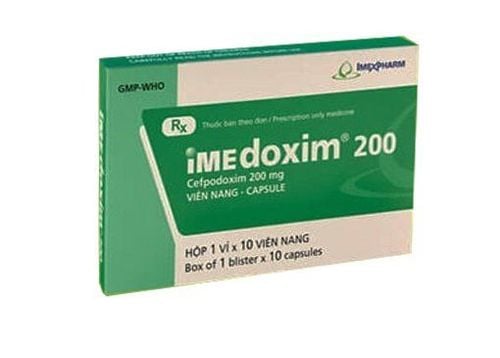This is an automatically translated article.
Antipodox is an oral antibiotic used to treat mild to moderate bacterial infections. This is a 3rd generation cephalosporin antibiotic, so it has a broader spectrum of activity against gram-negative bacteria than previous generations.1. What is Antipodox 100?
The main ingredient of Antipodox 100 is Cefpodoxime proxetil 100mg, which is prepared in the form of film-coated tablets. Cefpodoxime is a broad-spectrum 3rd generation cephalosporin antibiotic. The drug has high stability against the attack of beta-lactamase enzymes, produced by gram-negative and gram-positive bacteria.The antibacterial action of Cefpodoxime is obtained through inhibition of bacterial cell wall synthesis, which in turn, through acylation of membrane-bound transpeptidase enzymes, which prevents cross-linking of peptidoglycan chains essential for the strength and durability of the bacterial cell wall.
Cefpodoxime proxetil has a broad spectrum of activity against bacteria such as:
For gram-positive bacteria, this antibiotic includes Staphylococcus aureus with the exception of methicillin-resistant Staphylococci, Streptococcus pyogenes, Streptococcus pneumoniae, Streptococcus agalactiae and Streptococcus spp. Gram-negative bacteria include beta-lactamase-producing and non-beta-lactamase-producing strains such as H. influenzae, H. para-influenzae, Moraxella catarrhalis, Neisseria meningitidis, Neisseria gonorrhoea, Klebsiella pneumoniae, Proteus vulgaris, Providencia rettgeri and Citrobacter diversus, E. coli.
2. Indications and contraindications for using Antipodox 100
2.1. Point
Antipodox 100 is indicated for the treatment of bacterial infections including:Upper respiratory tract infections including acute otitis media, rhinosinusitis, tonsillitis and pharyngitis. But this is not the drug of choice, but only when appropriate antibiotics do not respond or respond poorly. Community-acquired pneumonia. Uncomplicated acute gonococcal infection. Uncomplicated urinary tract infections such as urethritis, cystitis. Infections of the skin and skin structures.
2.2. Contraindications
Antipodox 100 should not be used in the following cases:This drug is not contraindicated in patients with a history of hypersensitivity to cefpodoxime proxetil and other components of the drug. Be careful when using the drug because it can cause cross-allergic reactions with other cephalosporins or penicillins.
3. Dosage and how to use Antipodox 100
3.1. How to use
The drug is taken orally with water. Patients should take Antipodox with food.For patients with difficulty swallowing, you can keep the tablet in your mouth for 1-2 minutes and then swallow it or you can put the tablet in water until it disintegrates and then drink it.
3.2. Dosage
Dosage of Antipodox 100 you can refer to as follows:Adults:
Upper respiratory tract infections including otitis media, tonsillitis and nasopharyngitis, sinusitis: Use at a dose of 100mg every 12 hours for 10 day. Community-acquired acute pneumonia: 200mg every 12 hours for 14 days. Uncomplicated acute gonococcal infection: Use a single dose of Antipodox 200mg. Uncomplicated urinary tract infections: 100mg every 12 hours for 7 days. Skin and skin structure infections: Antipodox 400mg every 12 hours for 7-14 days. Children:
Acute otitis media: Take Antipodox at a dose of 10mg/kg/day (maximum do not exceed 400mg/day in 2 divided doses) within 10 days. Pharyngitis, tonsillitis, VA: Use at a dose of 10mg/kg/day (maximum no more than 200mg/day in 2 divided doses) for 10 days. For other infections: Not recommended. Renal Impairment: For patients with moderate to severe renal impairment with creatinine clearance less than 30 ml/min, the dosing interval should be increased to 24 hours.
Elderly: Use dose based on renal function.
No dose adjustment is required in cirrhotic patients.
Missed dose and overdose:
Missed dose: When taking Antipodox 100, if you forget to take a dose, you should take it as soon as possible. However, if it is too close to the next dose, skip the missed dose. Should set the time to take the medicine, should not forget the medicine because it reduces the bactericidal effect of the drug. Overdose: After an acute overdose, most symptoms cause only nausea, vomiting, and diarrhea. However, it can cause neuromuscular hypersensitivity and cause seizures, especially in patients with renal failure. When taking an overdose of the drug than the prescribed dose, you should immediately go to medical facilities for treatment and supportive treatment measures.
4. Side effects when using Antipodox 100
Side effects of Antipodox 100 are usually mild and transient, rarely affecting the use of the drug. Some possible side effects include:Diarrhea, nausea, vomiting, abdominal pain, rash, urticaria, pseudomembranous colitis and headache. Rarely, hypersensitivity reactions itching, dizziness; confusion, agitation, trouble sleeping; thrombocytopenia or thrombocytopenia, leukopenia or eosinophilia; reversible interstitial nephritis. When taking Antipodox 100, patients need to monitor for symptoms of side effects. If there are side effects that worry you or serious side effects may occur, you should inform your doctor for advice.
5. Things to note when using Antipodox 100
Antibiotics only treat bacterial infections, not viruses. Therefore, you should only use it when prescribed by a doctor with a disease caused by a bacterial infection. Avoid self-administration when the infection is unknown or change the dose, use, or stop use without the consent of the doctor. Because, these practices increase the risk of bacterial drug resistance.As with other antibiotics, prolonged use may increase the risk of infection caused by bacteria that are not sensitive to this antibiotic. Especially colitis, so when taking the drug, it is necessary to think of pseudomembranous colitis if diarrhea persists after taking cefpodoxime proxetil.
Particular caution should be exercised in pre-administered patients who have had an anaphylactic reaction to penicillin. Cefpodoxime proxetil should not be administered to patients with a history of sensitivity to cephalosporins or other beta-lactams.
For pregnant women: Studies have been conducted in a variety of experimental animals, and at present, no teratogenic or fetotoxic effects have been found. Therefore, Antipodox 100 can be prescribed for pregnant women, but should only be used when absolutely necessary.
Lactating women: Although the drug only passes into breast milk a very small amount, but due to the severe reaction caused by the drug in nursing infants, before taking it, it is necessary to carefully decide between whether to stop breastfeeding. or stop taking the drug.
Drugs that can alter laboratory values: use of cephalosporins causes a positive direct Coomb test.
Drug interactions:
Drug concentrations in the blood plasma are reduced by about 30% when Cefpodoxime proxetil is used together with antacids or H2 inhibitors. Therefore, these drugs should be taken at least 2 hours apart. When the antibiotic cefpodoxime is prescribed concurrently with compounds known to be nephrotoxic, renal function should be closely monitored. Plasma concentrations of cefpodoxime are increased when cefpodoxime is coadministered with probenecid due to decreased elimination. This increases the effect of the drug, but also increases the risk of overdose and side effects. Storage: Store Antipodox at a temperature below 25 degrees Celsius, protected from light and moisture. Medicines should be kept out of reach of children and pets.
Above is the information about the drug Antipodox 100mg. Medicines are prescribed by a doctor to treat bacterial infections. If you have any questions before taking the medicine, ask your doctor.
Please dial HOTLINE for more information or register for an appointment HERE. Download MyVinmec app to make appointments faster and to manage your bookings easily.













